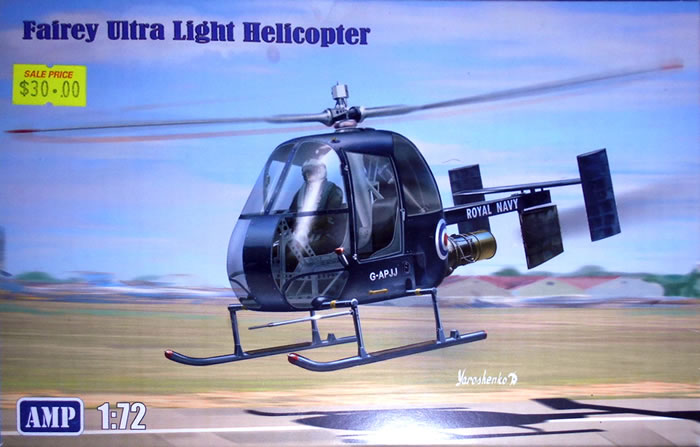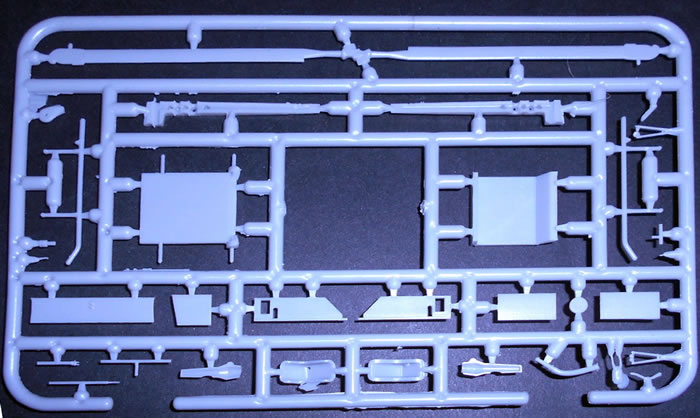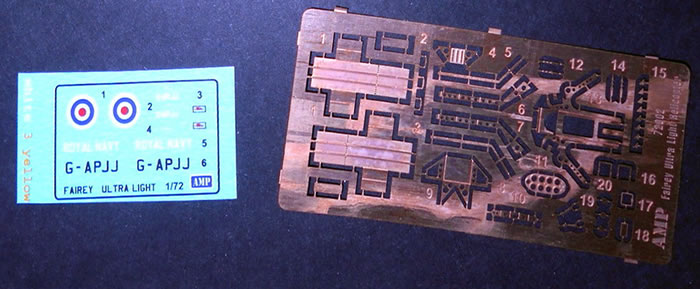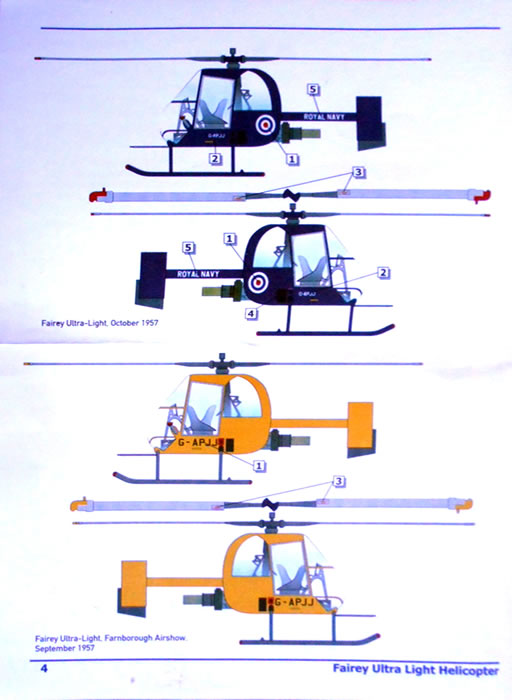Fairey Ultra Light Helicopter

AMP, 1/72 scale
S
u m m a r y : |
Description and Item No.: |
AMP Kit No. 72002 - Fairey Ultra Light Helicopter |
Contents and Media: |
31 parts in grey low pressure plastic; one photo-etched fret with around 36 parts; two resin parts; two parts in clear(ish) plastic; instructions; decals for two marking options. |
Price: |
AUD$30.00 plus shipping available online from Creative Models Australia
and hobby retailers worldwide |
Scale: |
1/72 |
Review Type: |
First Look |
Advantages: |
An interesting aircraft and the kit has well-moulded parts, excellent decals, PE, masks and instructions. |
Disadvantages: |
Very disappointing transparencies in my example. |
Recommendation: |
This is a lovely kit of an interesting little helicopter which is unlikely to be kitted by anyone else. It is a shame that my transparencies are so poor in such an expensive kit. |
Reviewed by Graham Carter

This tiddly little helicopter was designed in 1953-4 for reconnaissance and casevac work by Fairey Aviation, but received little support and the RAF selected the SARO Skeeter instead. Some attempt was made at Farnborough to promote it to the civil market but to no avail. There were five or six built Three is some argument here), with later ones having slightly enlarged cockpit area as modelled in this kit. It was powered by a Turbomeca Palouste engine of French origin and weighed only 290kg empty, 820kg loaded. It demonstrated amazing manoeuvrability with rapid take-off and dramatic descents and was shown at Farnborough landing and taking-off from a 3-ton moving truck. Trials at sea in 1957 on the frigate HMS Grenville indicated that it could cope with landings in winds up to 62 knots ( about 120kph) deck pitching of over 10 feet (3-3.5m) and up to 14° roll. A pretty amazing little piece of equipment.
I purchased the kit myself last year from Glen at Creative Hobbies. The kit comes in the usual Eastern European flimsy end-opening box with a nice CG illustration on the top. Parts are exquisitely moulded and will need little trimming but lots of care removing them from the sprues as they are very fine. The PE is excellent, the resin provides the engine and exhaust and is bubble free, and the masks will be very useful.

The major issue comes with the ‘transparencies’ as they are pretty poor with a speckled finish that cuts out transparency as shown in the image provided. I will try to polish mine out but am not that confident. What a pity, and disappointing as it is not a cheap kit. Interestingly, there is a build article OAMS (on another modelling site) in which the transparency is much clearer than mine so maybe this is just a bad example - oh well!
Instructions are excellent, clear and with good painting instructions at each stage. The interior is a work of art with some 25 plastic and PE parts and it would be worth putting the effort into opening up the doors to show all the detail inside.

Note that in the military version the observer’s seat (port side) faced the rear as kitted, but a civil one would have both seats facing forward.
Marking Options
Decals are nicely printed.

They represent the single aircraft produced, G-APJJ on two dates:
-
Royal Navy trials in overall blue with white serials and roundels, and
-
at Farnborough Airshow in overall yellow with black serials.
This aircraft is preserved at the Midland Air Museum and another one is being readied for display at the Helicopter Museum at Weston-super-Mare in England.
This is a lovely kit of an interesting little helicopter which is unlikely to be kitted by anyone else. It is a shame that my transparencies are so poor in such an expensive kit
Purchased by reviewer
Text and Images Copyright © 2020 by Graham Carter
Page Created 15 September, 2020
Last updated
15 September, 2020
Back to HyperScale Main Page
Back to Reviews Page |
Home
| What's New |
Features |
Gallery |
Reviews |
Reference |
Forum |
Search